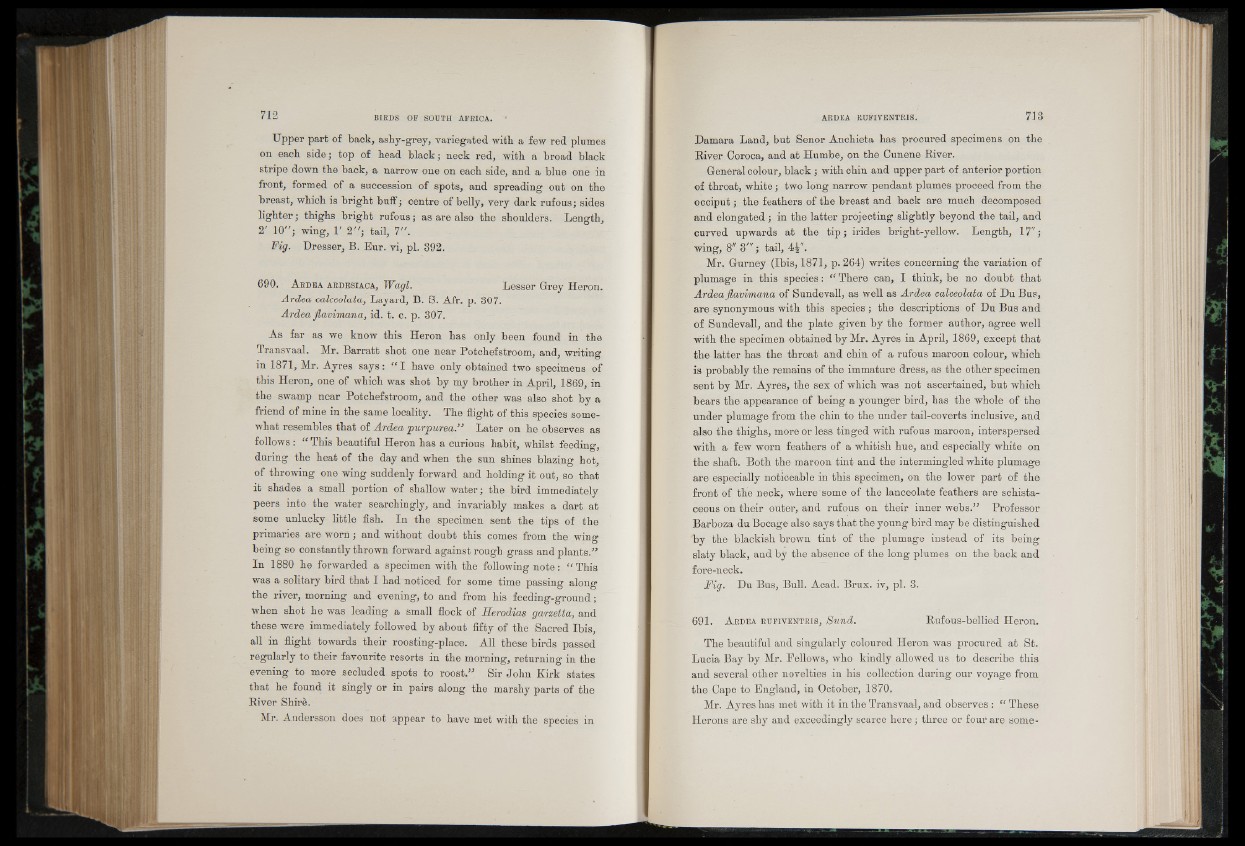
Upper part of back, ashy-grey, variegated with a few red plumes
on each side; top of head black; neck red, with a broad black
stripe down the back, a narrow one on each side, and a blue one in
front, formed of a succession of spots, and spreading out on the
breast, which is bright buff; centre of belly, very dark rufous; sides
lighter; thighs bright rufous; as are also the shoulders. Length,
2 ' 10"; wing, 1' 2"; tail, 7".
Fig. Dresser, B. Eur. vi, pi. 392.
690. A rdea ardesiaca, Wagl. Lesser Grey Heron.
Ardea calceolata, Layard, B. S. Afr. p. 307.
Ardea fiavimana, id. t. c. p. 307.
As far as we know this Heron has only been found in the
Transvaal. Mr. Barratt shot one near Potchefstroom, and, writing
in 1871, Mr. Ayres says: “ I have only obtained two specimens of
this Heron, one of which was shot by my brother in April, 1869, in
the swamp near Potchefstroom, and the other was also shot by a
friend of mine in the same locality. The flight of this species somewhat
resembles that of Ardea purpurea.33 Later on he observes as
follows : “i This beautiful Heron has a curious habit, whilst feeding,
during the heat of the day and when the sun shines blazing hot,
of throwing one wing suddenly forward and holding it out, so that
it shades a small portion of shallow water; the bird immediately
peers into the water searchingly, and invariably makes a dart at
some unlucky little fish. In the specimen sent the tips of the
primaries are worn; and without doubt this comes from the wing
being so constantly thrown forward against rough grass and plants."
In 1880 he forwarded a specimen with the following note: "This
was a solitary bird that I had noticed for some time passing along
the river, morning and evening, to and from his feeding-ground;
when shot he was leading a small flock of Herodias garzetta, and
these were immediately followed by about fifty of the Sacred Ibis,
all in flight towards their roosting-place. All these birds passed
regularly to their favourite resorts in the morning, returning in the
evening to more secluded spots to roost." Sir John Kirk states
that he found it singly or in pairs along the marshy parts of the
River Shire.
Mr. Andersson does not appear to have met with the species in
Damara Land, but Senor Anchieta has procured specimens on the
River Coroca, and at Humbe, on the Cunene River.
General colour, black ; with chin and upper part of anterior portion
of throat, white; two long narrow pendant plumes proceed from the
occiput; the feathers of the breast and back are much decomposed
and elongated; in the latter projecting slightly beyond the tail, and
curved upwards at the tip; irides bright-yellow. Length, 17";
wing, 8" 3"'; tail, 4|".
Mr. Gurney (Ibis, 1871, p. 264) writes concerning the variation of
plumage in this species: “ There can, I think, be no doubt that
Ardea flavimana of Sundevall, as well as Ardea calceolata of Du Bus,
are synonymous with this species; the descriptions of Du Bus and
of Sundevall, and the plate given by the former author, agree well
with the specimen obtained by Mr. Ayres in April, 1869, except that
the latter has the throat and chin of a rufous maroon colour, which
is probably the remains of the immature dress, as the other specimen
sent by Mr, Ayres, the sex of which was not ascertained, but which
bears the appearance of being a younger bird, has the whole of the
under plumage from the chin to the under tail-coverts inclusive, and
also the thighs, more or less tinged with rufous maroon, interspersed
with a few worn feathers of a whitish hue, and especially white on
the shaft. Both the maroon tint and the intermingled white plumage
are especially noticeable in this specimen, on the lower part of the
front of the neck, where some of the lanceolate feathers are schista-
ceous on their outer, and rufous on their inner webs." Professor
Barboza, du Bocage also says that the young bird may be distinguished
by the blackish brown tint of the plumage instead of its being
slaty black, and by the absence of the long plumes on the back and
fore-neck.
Fig. Du Bus, Bull. Acad. Brux. iv, pi. 3.
691. A rdea r u f iv en t r is , Sund. Rufous-bellied Heron.
The beautiful and singularly coloured Heron was procured at St.
Lucia Bay by Mr. Fellows, who kindly allowed us to describe this
and several other novelties in his collection during our voyage from
the Gape to England, in October, 1870.
Mr. Ayres has met with it in the Transvaal, and observes : " These
Herons are shy and exceedingly scarce here; three or four are some